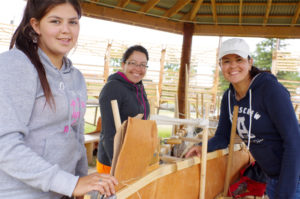Youth prepare for launch of hand-made birch bark canoe

By Rick Garrick
FORT WILLIAM FIRST NATION—A group of Fort William youth is planning to launch the 18-foot birch bark canoe they built this summer with instructor Darren Lentz, in mid-August.
“We’re supposed to go after we’re done next week some time,” says Tanya Fenton, one of the youth who learned how to build the canoe. “[Lentz] said that we would take it on Lake Superior.”
Fenton was surprised to see where some of the birch bark canoe parts came from during the four weeks of canoe building sessions on Mount McKay. The youth began working on the canoe in mid-July, but they had to work on other projects as well throughout the summer.
“We had to get our own roots from the bush,” Fenton says. “We spent hours on our hands and knees getting our fingers dirty to pick the roots that we used to sew the canoe together.”
Fenton appreciated the information she learned during Lentz’s canoe building sessions.
“He taught us everything we needed to know to build our own,” Fenton says. “I’m confident to say that I probably know how to build one. It’s a good thing to learn because if you needed to build your own type of transportation, you would know how. And you can teach people, like your relatives.”
Shaylah Fenton, Tanya’s niece, also enjoyed learning how to build a birch bark canoe.
“I enjoyed all of it and I think it’s cool that we get to learn things like this,” Shaylah says. “The sewing on the canoe, I enjoyed that.”
Lentz says Shaylah is the “master at lashings.”
“She’s done some beautiful lashings,” Lentz says. “They just put a lot of effort into their work, and I think that’s because they actually went out and picked the roots and harvested them, peeled them and split them. So they gain an appreciation for the size of roots they need to do the lashing, and the better the root, the longer the root, the nicer the root, the easier it is to do the lashing.”
Lentz says the youth also learned lessons through their interactions with the materials and the land.
“That’s why I always say the canoe does the teaching,” Lentz noted. “I’m just here to facilitate the process.”
Lentz says this year’s canoe is bigger than the one another group of Fort William youth built and launched last summer.
“This is the biggest one I’ve built yet,” Lentz says. “Usually I build them 15-16 feet, and this is 18 [feet long].”
Lentz says the birch bark was harvested from west of Thunder Bay.
“We got some big pieces, but you can see on the side of the canoe that they had to add a piece,” Lentz says. “We wanted to make it fairly deep to handle the lake, so we had to add some side panels to it. And that was a long part of doing it, sewing those side panels all the way along the length of the canoe.”
Miranda Fenton, Tanya’s sister, says the youth created contests amongst themselves during the different parts of the canoe building process.
“We had contests going to see who could pick the most roots, who could pick the longest roots,” Miranda says. “They had a lot of fun.”
The group of eight to 12 youth began building the canoe by sewing the birch bark pieces together.
“It was good to see the kids all getting along and laughing and telling stories while we were building the canoe,” Miranda says. “It was a good atmosphere for the kids for the summer, to be in nature instead of maybe playing video games or being indoors watching television.”


